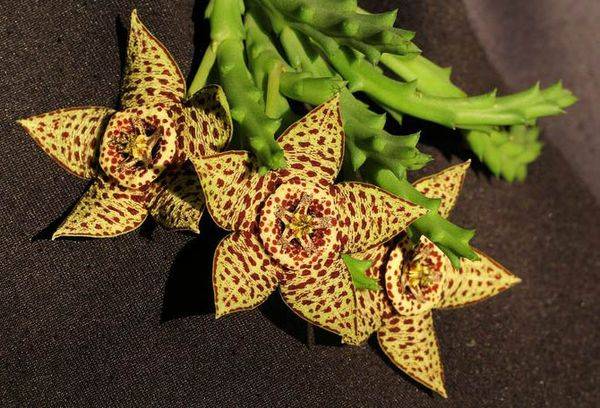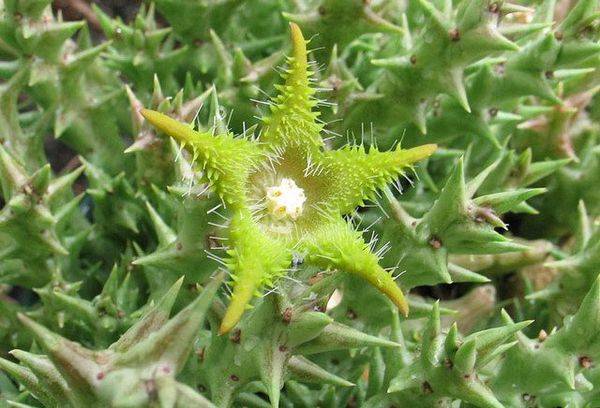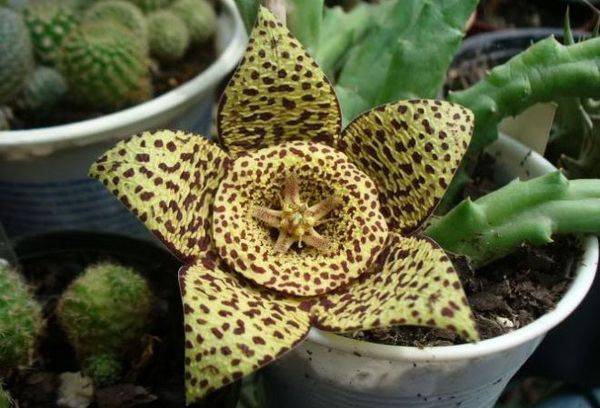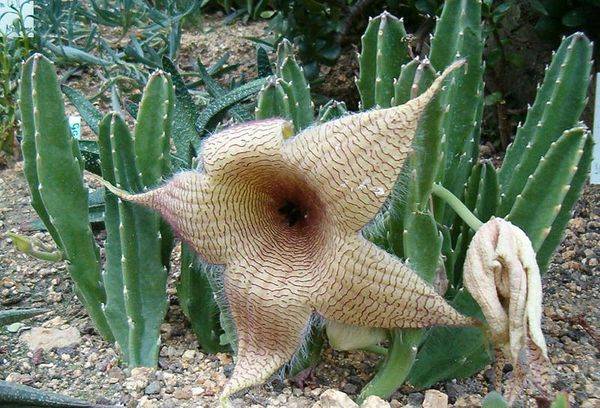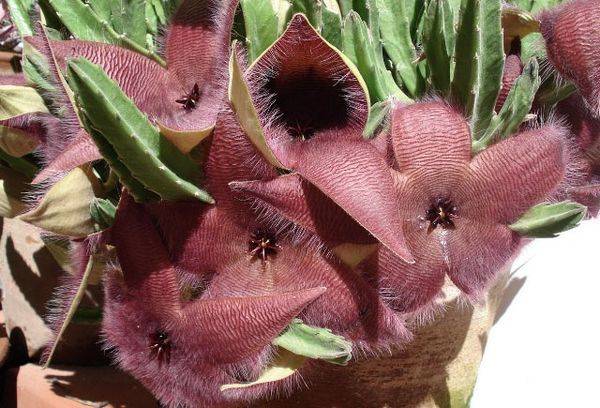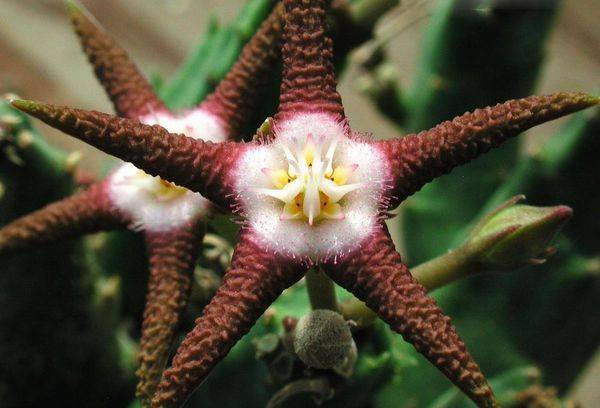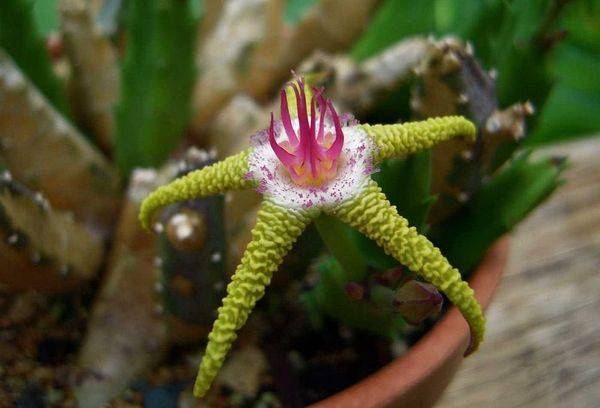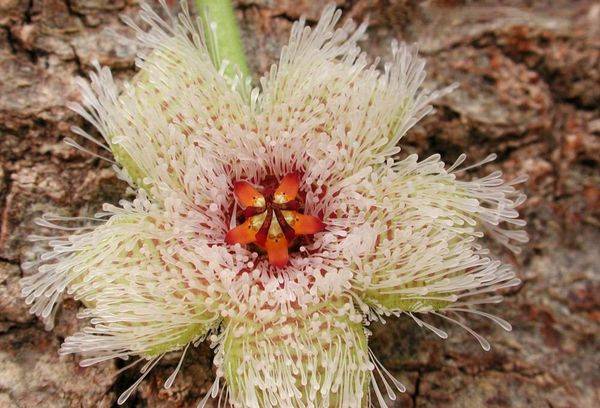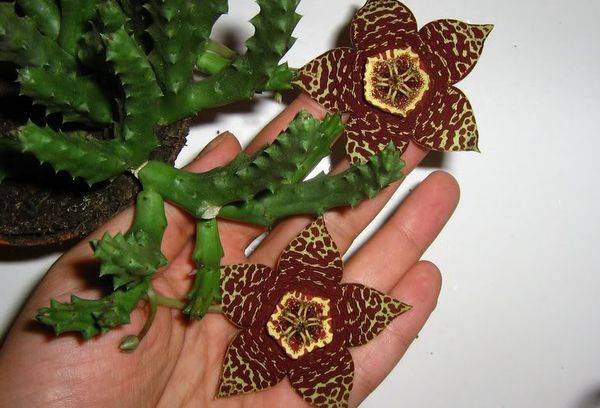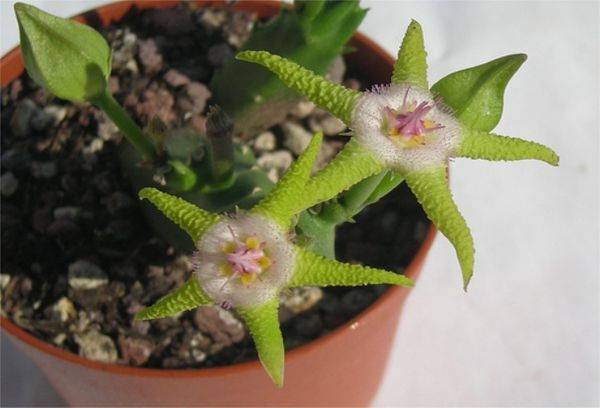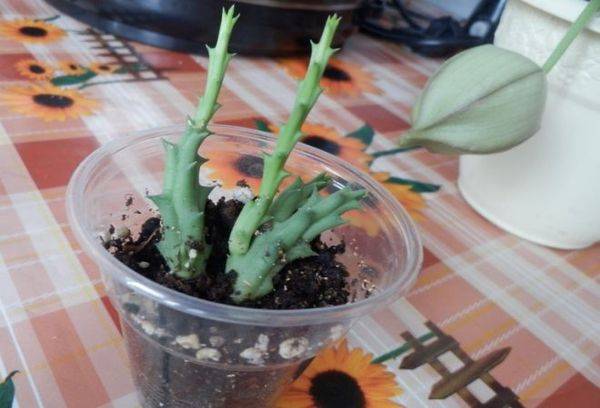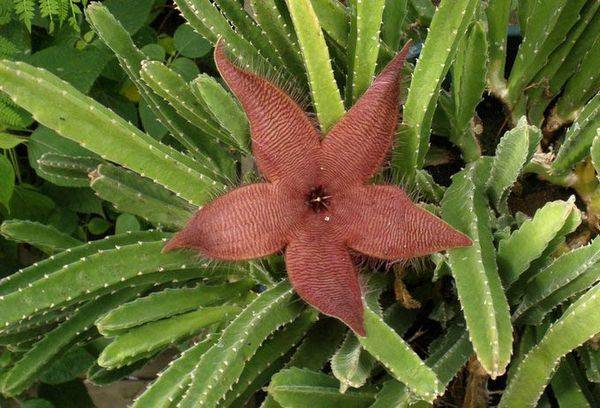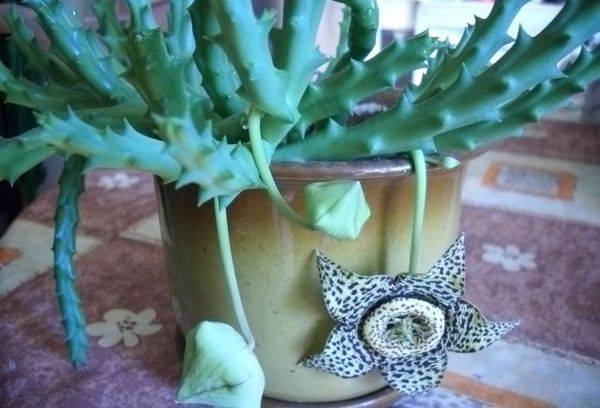"The most beautiful and monstrous flowers": all about the slipway
Content:
The article is devoted to highly decorative succulents from the African continent - slipway. How to properly care for this unusual plant at home? It is only necessary to bring the conditions of detention closer to natural conditions, which is not particularly difficult, so the slipway is suitable for growing not only for professionals, but also for beginners in floriculture.
Before you get this angular green inhabitant, answer the question: are you ready to put up with the unpleasant specific smell that a flower emits to attract insects? Stapelia is a combination of incongruous: beautiful flowers and unimaginable stench.
What is interesting stapelia
Stapelia is a representative of the family gianaceae, a perennial of small size. The genus Stapelia has about 75 species. This plant is succulent, that is, it is able to accumulate moisture in its stems. The shoots of the plant are fleshy, they have mainly 4 faces, but species with 5 and 6 faces are found. Because of the prongs on the edges of the shoots, the slipway is sometimes confused with a cactus.
Shoots have no leaves, often form processes at the base. Flowers are also usually located there. They are of interest to flower growers. In shape it is a cup with five petals. The flower looks like a symmetrical five-pointed star. For all the beauty of its color and shape, there is one feature: the flower smells terribly. The smell serves to attract insects, or rather flies. Only these creatures pollinate the slipway.
The homeland of the plant is South-West and South Africa, some species are found in East Africa. Stapelia grows on the slopes of high mountains. It is obscured by nearby trees and shrubs. Succulents love the neighborhood with ponds. The slipway got its name in honor of the 17th century Dutch botanist I. B. van stapel. Goethe's writer spoke peculiarly about the plant: "These are the most beautiful and most monstrous flowers in the world."
Kinds
Basically, succulent species differ only in size. But there are slight differences in shades and even smells. Species that take root well at home:
- Stapelia motley - dwarf succulent, reaching a height of only 7-10 cm. Shoots have a green or reddish hue. No more than 5 flowers are formed on the basis of a fresh shoot. The species is interesting in the color of flowers: yellow petals, covered with brown spots or short stripes. Outside, the petals are smooth, and folded closer to the center. A roller is placed in the middle. This species is very resistant to uncomfortable conditions.
- Giant stapelia - The owner of large flowers, eye-catching. The diameter of the flowers reaches 30-35 cm. Petals of the slipway are yellow, decorated with raspberry hairs, have an elongated shape, pointed and bent to the edge. One or two flowers are formed on one plant. Unlike other species, this stapelia does not have a pronounced unpleasant odor.
- Grandiflora stapelia (large-flowered). The most popular species in floriculture. This plant is characterized by a complex color. Below the flower is bluish-green, above - purple and striped. Petals are lanceolate, covered with a layer of small villi. During flowering, they are wide open, after 2-3 days they begin to bend back. The peculiarity of the variety is a pronounced unpleasant odor reminiscent of rotten fish.
- Stapelia ferruginous. The shoots of this succulent reach 15 cm in height, straight, 3 cm thick, with pterygoid dentate faces.Flowers on long pedicels, medium-sized, yellow-green with pink spots. Petals bent to the edge and covered with long white villi.
- Golden purple stapelia grows no more than 10 cm in height. Shoots are light green, sometimes purple, differ in smooth edges. The flowers are located on the tops of young shoots in an amount from 1 to 3. They are small (up to 4 cm in diameter), light green, wrinkled, with narrow and spiky petals. This is a rare sample with a pleasant smell reminiscent of church wax.
- Stapelia ferruginous. Her flowers are covered with many hairs, transparent in the center and white at the tip. Coloring - pale yellow with pink dots. The flower itself is small (up to 5 cm in diameter), the petals are triangular.
Care Rules
Plant care begins with a choice of location. Place the pot in a well-lit area with slight shading. The flower will be comfortable on the west or east side. If the pot is placed on the south window, then you need to create artificial shading. What is the danger of direct sunlight? Instant severe burn.
In the summer, slipways will be useful to be outdoors, for example, on the balcony. But, since sunlight is dangerous for burn shoots, arrange shading at noon. In winter, an additional shadow is not required, it is better to put the pot away from the balcony and batteries. But with the onset of spring, you need to gradually accustom the plant to a change in lighting.
Tip
If the plant has been kept in the shade for a long time, then it should be displayed in the sun very carefully and gradually.
Succulent is watered depending on the time of year. From the beginning of spring to mid-autumn stapelias require a large amount of water. Watering is carried out from above, so that the entire substrate is moistened. Each subsequent application of water is carried out after drying of the top layer of the earth. This is important, since the plant does not tolerate the flooding of the root system. In cold weather, watering is reduced. Sometimes the shoots wrinkle a little. This is a sign that you need to slightly increase the amount of water. But in general, in winter, watering should be limited as much as possible.
In the period from the beginning of spring to mid-autumn, the optimum temperature for stapelia is + 22-26⁰ C. With the onset of autumn, the temperature is gradually reduced, preparing the succulent for the rest period. In winter, the plant is kept in a cool room from +12 to + 15⁰. Stapelia does not like sudden changes in temperature. Therefore, keep the plant pot away from drafts. As for humidity, it does not play a big role. Succulent well tolerates dry air.
Soil and fertilizer
Stapelia is not demanding on the nutritional value of the soil, but its looseness is of great importance. The substrate should have an acidity in the range of pH 5.5-7. In the flower shop, ready-made soil for succulents and cacti is presented. To grow a slipway in it, add a few pieces of charcoal. purityis.decorexpro.com/en/ magazine has collected information on self-preparation of substrates for slipways.
You will need:
- turf land - 2 parts;
- sand (preferably coarse) - 1 part.
The best time for fertilizing is spring and summer, when the plant is actively developing. Feeding is carried out every 2 weeks. You can purchase special mixtures for cacti and succulents. Be sure to follow the manufacturer's recommended proportions. Stapelia needs potassium fertilizer. Such complementary foods provide plant protection against pests. During dormancy, fertilizers are not applied.
Transplantation, propagation by seeds and cuttings
Young slipways are transplanted annually with the onset of spring. Adult plants need a change of pot and substrate no more than once every 2-3 years.
What you need to know about transplanting adult samples:
- you need to remove the shoots located in the middle, since they will not bloom;
- the pot is selected shallow, as the slipway is not too developed root system;
- plastic containers retain moisture better;
- the drainage layer at the bottom of the pot should occupy 1/3 of the capacity;
- use expanded clay as drainage;
- transplantation is done by transshipment, without removing a lump of earth from the roots;
- transplanted flowers are not watered for a week so as not to damage the root system.
Reproduction is carried out using seeds and cuttings:
- Seeds are well tied, but ripen for a long time (within a year). Ripe seeds are planted in a loose sandy substrate, where they germinate for a month. Then they are dived and planted in small pots with a diameter of 6-7 cm in the soil for adult plants. After a year, the plants grow into a larger pot.
- Cuttings for propagation are taken from old shoots. Before planting them in a sandy peat substrate, they are slightly dried. Rooting is fast. After the stalk has acquired roots, it is transferred to a more capacious pot.
Flowering and dormancy
Typically, flowering occurs from late spring to late summer. It is during this period that the slipway most of all needs lighting, watering, top dressing and fresh air. Flowers are formed at the base of the shoots. Some species give several pieces; on others, only one flower is tied. Their beauty is in symmetry, fluffy, bright color. But some samples smell wildly, one might say stink. The smell attracts flies that pollinate a flower.
On average, one flower lasts up to 3 days, then closes. It is better to remove wilted flowers so that the plant can grow new ones. The flowering period takes from two weeks to two to three months. Its beginning cannot be missed: a characteristic aroma will spread in the room. But not all types of succulents smell sharply. So, the giant stapelia is odorless, and the golden purple stapelia smells pretty nice.
With the onset of autumn, a slipway is prepared for wintering. Reduce the temperature, reduce lighting and the amount of water should be gradual, as the plant does not tolerate sudden changes. In winter, slipway is kept in cool conditions. If you provide the flower with a temperature within + 12-16 ° C, then a new flowering period will begin earlier.
Diseases and Pests
In the wild, the plant lives in fairly harsh conditions. Despite resistance to diseases and pests, stapelia can be affected. The reason for this is inattention and illiterate care. So, at low air temperature, the plant is affected by a spider mite. Another lover of spoiling a home slipway is aphids. Insects get rid of insecticides.
The cause of troubles, most often, is overmoistening of the soil. In conditions of excess moisture, the flower is affected by the mealybug. If you start the situation, it will save the slipway only by cutting off the cuttings. The affected plant must be disposed of with the pot and soil. The place where the pot stood should be disinfected.
Care Tips
How to make the conditions of the slipway as comfortable as possible and what else you should know about the plant:
- Use tulle or paper to create the shadow.
- Water for irrigation is necessarily warm and settled.
- Plants grown from seeds may differ from their parents. This is due to the tendency of the slipway to cross.
- If the stapelia does not want to bloom, try adding potash fertilizers.
- In cases of lack of lighting, the plant will turn yellow. Shade the flower without fanaticism.
- With a lack of lighting, stalk extension is inevitably observed.
- How to understand that the plant received a sunburn? Brown spots appear on its shoots. Urgently need to change the location of the pot.
- If the stems become sluggish, this is a sign of excess water. If you overdo it with watering in the winter, there is a risk that the plant will turn white or even rot.
- Stapelia juice is toxic and irritates the mucous membranes.Work with the plant in protective gloves, do not allow pets to it.
- In order not to disturb adult plants once again, replace the topsoil annually instead of frequent transplants.
- The fruit of the plant resembles the tail of a swallow.
- As the flower warms up with the sun, its smell intensifies. Consider this when growing odorous species. It is better to buy bad-smelling plants if you can put them on a balcony or loggia.
- Stapelia looks beautiful in hanging pots: stems with flowers hang down in a cascade.
- Specialists in the study of plant energy argue that stapelia is able to heal mental wounds, create a harmonious atmosphere.
Stapelia is an unusual guest of the windowsill. In the plant world there are few of the same outlandish flowers. Against the cultivation of this plant can speak only its specific smell. But it is he who attracts some gardeners, not to mention exotic star-shaped flowers of incredible color. Stapelia is a great solution to diversify and revitalize the interior.
